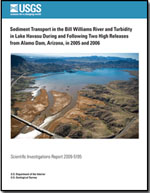Discharges higher than are typically released from Alamo Dam in west-central Arizona were planned and released in 2005, 2006, 2007, and 2008 to study the effects of these releases on the Bill Williams River and Lake Havasu, into which the river debouches. Sediment concentrations and water discharges were measured in the Bill Williams River, and turbidity, temperature, and dissolved oxygen were measured in Lake Havasu during and after experimental releases in 2005 and 2006 from Alamo Dam. Data from such releases will support ongoing ecological studies, improve environmentally sensitive management of the river corridor, and support the development of a predictive relationship between the operation of Alamo Dam and downstream flows and their impact on Lake Havasu and the Colorado River.
Elevated discharges in the Bill Williams River mobilize more sediment than during more typical dam operation and can generate a turbidity plume in Lake Havasu. The intakes for the Central Arizona Project, which transfers Colorado River water to central and southern Arizona, are near the mouth of the Bill Williams River. Measurement of the turbidity and the development of the plume over time consequently were important components of the study. In this report, the measurements of suspended sediment concentration and discharges in the Bill Williams River and of turbidity in Lake Havasu are presented along with calculations of silt and sand loads in the Bill Williams River.
Sediment concentrations were varied and likely dependent on a variable supply. Sediment loads were calculated at the mouth of the river and near Planet, about 10 km upstream from the mouth for the 2005 release, and they indicate that a net increase in transport of silt and a net decrease in the transport of sand occurred in the reach between the two sites.


